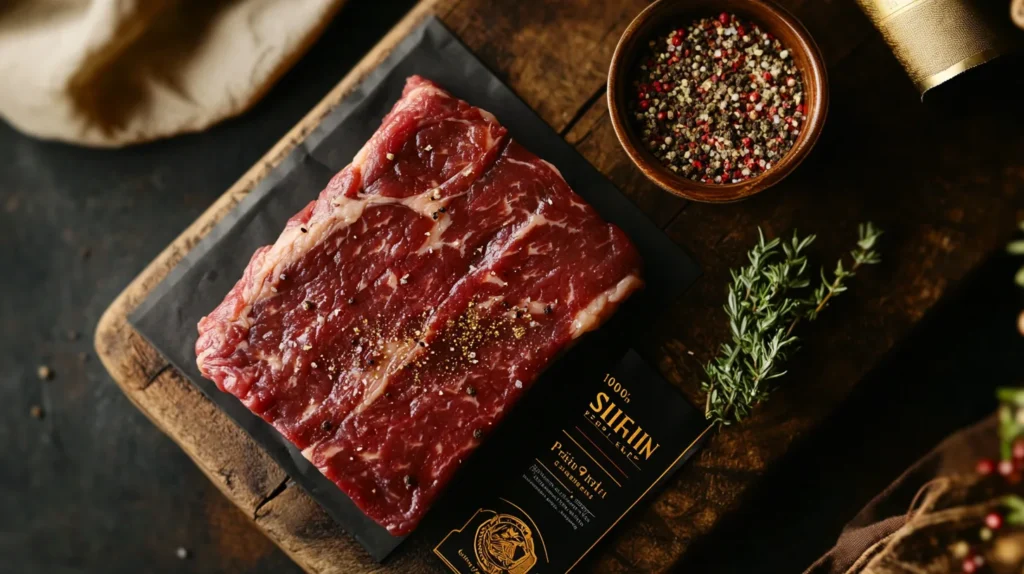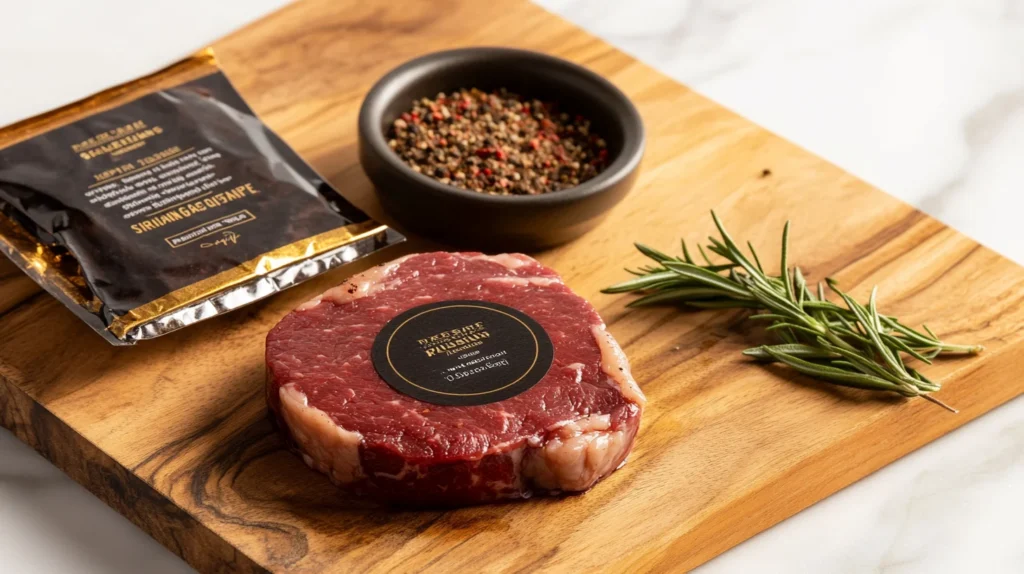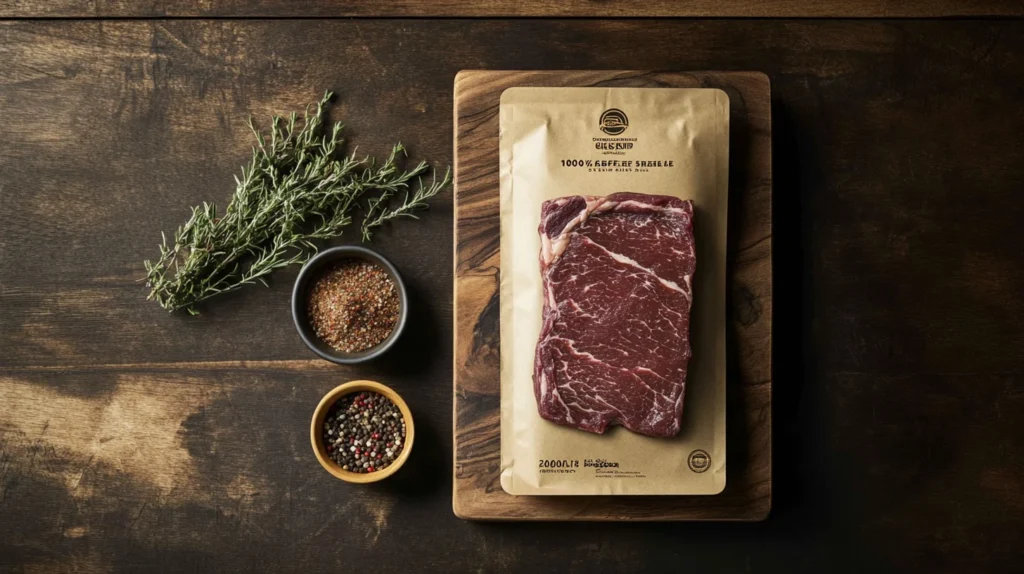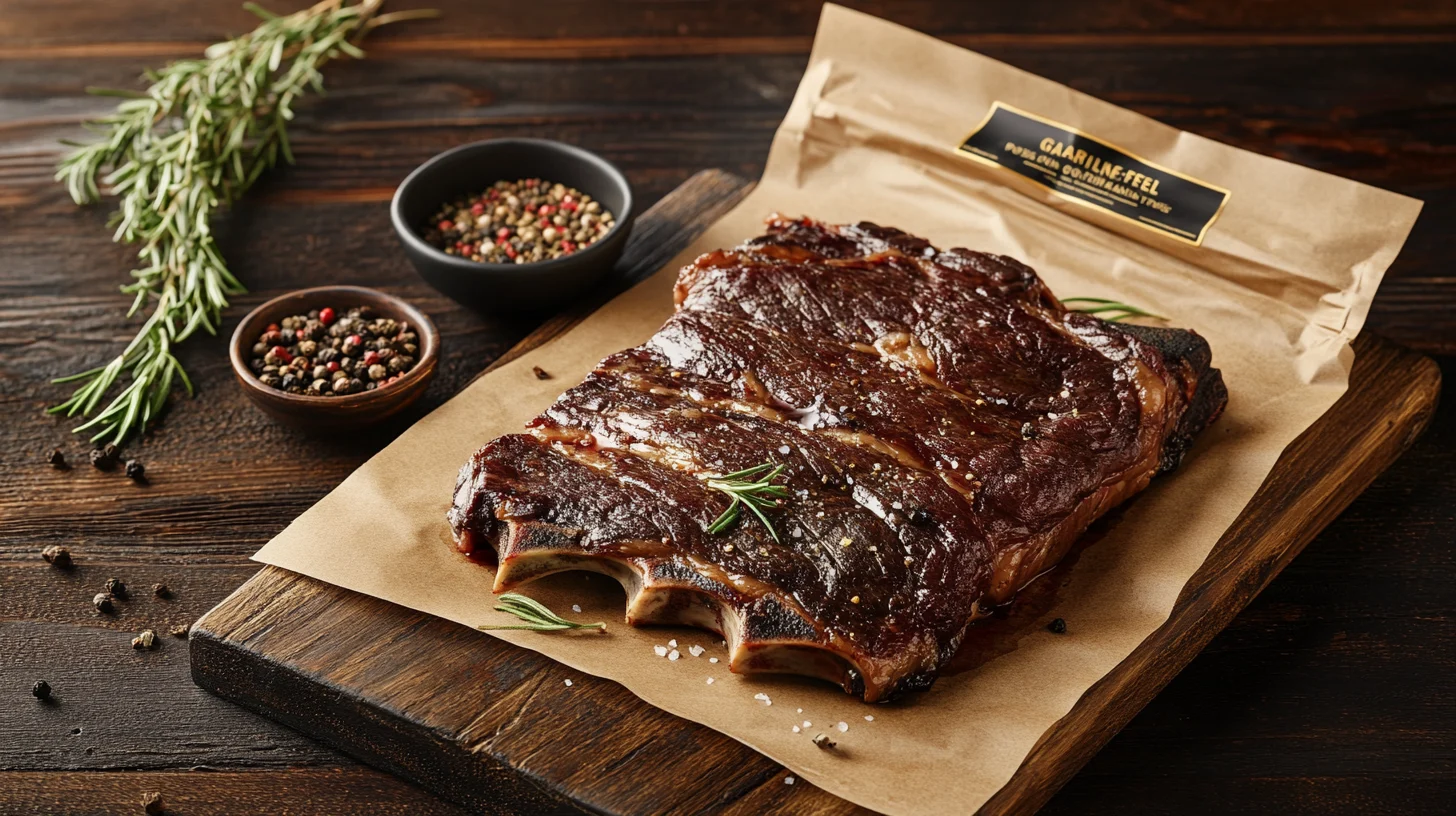Unraveling the Sirloin Steak Meat Label – A Deep Dive into Quality and Transparency
When you pick up a package of sirloin steak at the grocery store, the sirloin steak meat label is your gateway to understanding what you are about to purchase. The label reveals essential information that can guide your shopping choices, from nutritional content to sourcing practices. In this comprehensive guide, we’ll dissect the anatomy of sirloin steak labels to empower consumers with knowledge about their meat.
Understanding Sirloin Steak Meat Labels: A Comprehensive Guide
In today’s meat market, transparency is paramount. Consumers deserve to know where their food comes from, how it was produced, and what’s in it. This is where meat labeling becomes crucial. Sirloin steak labels not only serve as a source of information but also represent the quality and ethical standards behind the product. By understanding these labels, you empower yourself to make informed decisions about the food you consume.
The Importance of Meat Labeling
Meat labeling plays a vital role in ensuring that consumers can trust what they are purchasing. It serves as a communication tool between producers and shoppers, articulating essential details regarding the safety, origin, and characteristics of the meat.
Role of labeling in food safety
Food safety is one of the primary reasons for the existence of strict meat labeling regulations. Labels provide critical information on handling instructions, expiration dates, and storage recommendations, which help avoid foodborne illnesses. When you understand the sirloin steak meat label, you can take appropriate steps to ensure its safety before consumption.
For instance, a clear indication of the meat’s sell-by date helps you gauge its freshness. Additionally, certain labels may outline safe cooking temperatures to ensure the meat is prepared adequately. Overall, these safety protocols enable consumers to enjoy their steaks without worry.
Importance of ingredient disclosure
Ingredient disclosure goes beyond just listing the components within a steak; it encompasses various factors related to animal husbandry and feed. For example, terms like “grass-fed” or “grain-finished” indicate how the cattle were raised, which can influence both flavor and nutritional value.
By revealing the ingredients used in the production process, labels allow consumers to align their purchases with dietary needs or ethical considerations. If you’re avoiding antibiotics, hormones, or specific feeds due to allergies or personal beliefs, the insight provided by a well-detailed sirloin steak meat label is invaluable.
Consumer rights and informed choices
As a consumer, you have the right to make informed choices about the food you buy. Meat labels play a significant role in preserving that right, providing essential information about how the product is produced, processed, and packaged.
Understanding what’s on the sirloin steak meat label empowers you to support sustainable practices, select higher-quality cuts, and choose products that reflect your values. Informed consumers can also drive market demand toward better practices, ultimately leading to improvements in the meat industry as a whole.
Regulatory Standards and Guidelines
The meat labeling landscape is governed by various regulatory bodies that establish guidelines designed to safeguard consumer interests while promoting fair practices within the industry.

Overview of USDA regulations for meat labeling
The United States Department of Agriculture (USDA) sets forth stringent regulations concerning meat labeling. Their oversight ensures that meat products are accurately represented and that safety standards are maintained throughout the supply chain.
One key element of USDA regulations is the requirement for proper inspection and labeling of all meat products. Each package must include information such as the establishment number, which indicates where the meat was processed, and relevant safety certifications. This governmental oversight is critical to maintaining public health and ensuring the integrity of the meat supply.
Differences between local and international standards
While the USDA provides guidelines for meat labeling in the United States, other countries may follow different standards. Internationally, organizations like Codex Alimentarius set guidelines that many nations adopt to ensure food safety and quality.
These differences can create confusion for consumers who may be accustomed to specific labels in their home country. Understanding these variations can help you navigate the global meat market, ensuring that you make choices aligned with your expectations and preferences.
Key terms to understand (e.g., “grass-fed,” “organic”)
Various terms appear regularly on sirloin steak labels, each with distinct meanings and implications.
“Grass-fed” signifies that cattle were primarily fed grass rather than grain, which can result in a different flavor profile and lower fat content. On the other hand, “organic” indicates that the cattle were raised without synthetic pesticides or fertilizers, aligning with eco-conscious consumer preferences.
Understanding these key terms allows you to make more informed decisions about the types of meat you are willing to purchase and consume. More importantly, knowing the definitions helps prevent falling victim to marketing ploys that may not reflect the actual quality or ethics behind the product.
Anatomy of a Sirloin Steak Label
Now that we’ve examined the importance of meat labeling and the regulations surrounding it, let’s delve deeper into the specific components of a sirloin steak label. This knowledge arms you with the ability to interpret what you see when you encounter a sirloin steak in a store.
Product Name and Description
The product name and description on a sirloin steak meat label provide the first impression of the cut you’re considering. Understanding the nuances here is crucial for selecting the cut that aligns with your culinary intentions.
Breakdown of different types of sirloin cuts (e.g., top sirloin vs. bottom sirloin)
Sirloin steaks come in various cuts, each offering unique flavors and textures. Top sirloin is renowned for being tender and flavorful, making it an excellent choice for grilling or pan-searing. Conversely, bottom sirloin tends to be less tender but still carries robust beefy flavors, suitable for slow cooking or braising.
Different terminology can suggest differing qualities and preparations required for optimal taste. Familiarity with these distinctions enables you to choose the right cut based on your cooking method or personal preference.
Terminology used in product descriptions
Labels often use specific language to describe the steak, such as “dry-aged,” “wet-aged,” or “marbled.” Dry-aging refers to a process whereby beef is hung in a controlled environment, allowing moisture to evaporate and intensifying the flavor. Marbling, meanwhile, describes the intramuscular fat that contributes to tenderness and juiciness.
Understanding these terms provides insight into what you might expect regarding taste and texture. It also enhances your culinary adventures, as you’ll be better equipped to select cuts suited to your recipes.
Nutritional Information
A sirloin steak meat label typically includes a section dedicated to nutritional information. This segment is critical for consumers who are monitoring their dietary intake or seeking healthier protein options.
Common nutrients found in sirloin steak
Sirloin steak is a rich source of high-quality protein, essential for muscle development and overall health. It also contains vital vitamins and minerals, including B vitamins like niacin and B12, which are important for energy metabolism and red blood cell production.
Moreover, sirloin steak offers significant iron content, which is crucial for oxygen transport in the blood. Understanding the nutritional benefits of sirloin allows you to appreciate the value of incorporating it into a balanced diet.
Caloric content and serving sizes
Beyond nutrient types, it’s equally important to consider caloric content and serving sizes. A standard serving size of sirloin steak typically ranges around 3 to 4 ounces, containing approximately 200-300 calories, depending on the cut and cooking method.
Being aware of caloric content aids in meal planning, especially if you’re focusing on managing weight or adhering to specific dietary goals. Labels help simplify this process by presenting clear information, enabling you to make adjustments as needed.
Understanding the nutritional value per cut
Different cuts of sirloin can yield varying nutritional profiles. For example, while top sirloin is leaner, cuts like flank or skirt steak may contain higher fat levels. Being mindful of these differences allows you to choose cuts that best fit your dietary requirements and lifestyle choices.
Additionally, understanding how cooking methods affect nutritional value is essential. Grilling may render some fat, yielding a leaner final product, whereas frying in oil can increase calorie count. Knowledge of these variables ultimately supports healthier eating habits.
Quality Grades and Certifications
Quality grades and certifications signify the standard of the meat you’re purchasing. Familiarizing yourself with these indicators can enhance your selection experience.

Explanation of USDA quality grades (e.g., Prime, Choice, Select)
The USDA assigns quality grades based on marbling, tenderness, and age of the animal. The highest grade is “Prime,” known for its abundant marbling and superior taste, making it a go-to for discerning chefs and steak lovers alike. “Choice” represents high-quality meat with less marbling, while “Select” is leaner but still palatable.
These designations provide valuable insights into what you can expect regarding flavor, tenderness, and cooking performance. If you’re looking for an exceptional dining experience, Prime will likely deliver.
Additional certifications (e.g., Certified Angus Beef, grass-fed labels)
Beyond USDA grading, various certifications can further enhance your confidence in the product’s quality. For instance, “Certified Angus Beef” assures consumers that the meat meets specific criteria concerning breed, marbling, and tenderness.
Similarly, “grass-fed” labels confirm that cattle grazed on pasture, reflecting values tied to animal welfare and environmental sustainability. Recognizing these certifications helps legitimize your choice of meat and align it with your personal values.
The Impact of Origin and Sourcing on Labels
Origin and sourcing details on sirloin steak labels can significantly impact your perceptions of quality, taste, and ethical considerations. Understanding these aspects enriches your purchasing experience.
Traceability and Farm-to-Table
Traceability—the ability to track a product from farm to table—promises transparency in the meat supply chain. Many consumers seek out this information to ensure the meat they buy is ethically sourced and sustainably produced.
Importance of sourcing information on meat labels
Sourcing information informs consumers about where the meat originates, whether domestically or internationally. Knowing the source can impact your decisions, especially if you prefer purchasing locally raised animals. Local sources often tout fresher products and reduced carbon footprints associated with transportation.
Most importantly, specific sourcing claims can elevate a brand’s legitimacy, showcasing commitment to humane farming practices and animal welfare. As a conscientious consumer, you can make choices that resonate with your values.
How origin affects quality and taste of sirloin steak
The geographic region where cattle are raised can influence the meat’s flavor and quality. For example, grass-fed cattle raised in lush, green pastures typically produce meat that has a more pronounced grassy flavor compared to those finished on grain.
Environmental conditions also play a role in the overall growth and development of the animal, thereby impacting the quality of the meat. Awareness of these factors can lead to richer culinary experiences, as you’ll be able to select steaks that meet your taste expectations.
Ethical and Sustainable Practices
Many consumers are becoming increasingly aware of the ethical implications linked to meat production. Labels that reflect humane treatment of animals and sustainable practices contribute to the growing demand for responsibly sourced meat.
Labels reflecting humane treatment of animals
Some sirloin steak labels include certifications indicating adherence to humane animal welfare standards. These labels assure consumers that the cattle were treated ethically during their lives, promoting better living conditions and care.
Such certifications resonate with consumers who prioritize cruelty-free practices in their purchasing decisions. As awareness rises, brands acknowledging humane practices may gain competitive advantages in the marketplace.
Environmental considerations in meat production
The environmental impact of meat production cannot be overlooked. With issues like deforestation and greenhouse gas emissions linked to livestock farming, many consumers are seeking meat labeled as “sustainable.”
Sustainable practices, such as rotational grazing or organic feeding methods, can mitigate negative environmental impacts. Consumers who embrace these ideals can make more conscious choices, supporting brands committed to reducing the ecological footprint of meat production.
Common Mislabeling Issues
Despite regulations, mislabeling remains a significant challenge in the meat industry. Understanding how to identify misleading claims equips consumers to make better decisions.
Identifying Misleading Claims
Misleading labels can undermine consumer trust and compromise the integrity of the meat industry. Recognizing these pitfalls is essential for safeguarding your purchasing power.
Examples of common misleading labels
“Natural” is one term frequently found on meat labels, but it lacks a standardized definition. While it may evoke images of wholesome products, it doesn’t guarantee the absence of additives or processing.
Another example is “farm-raised,” which might imply ethical sourcing but could be misused without context. If the farming practices are unsustainable, the label loses its positive connotations. Learning to recognize such ambiguities can protect you from being misled.
Legal repercussions for mislabeling
Mislabeling isn’t just unethical; it can lead to legal consequences for companies caught falsifying claims. Regulatory agencies enforce penalties for deceptive practices, aiming to maintain industry integrity.
By understanding the seriousness of mislabeling, consumers can feel empowered to report suspicious claims. Communicating concerns regarding fraudulent practices can help foster a culture of accountability in the meat industry.
Consumer Awareness and Advocacy
Consumer advocacy plays a crucial role in improving meat labeling practices. Engaged consumers can inspire industries to adopt transparency and comply with ethical standards.

Promoting better practices in meat labeling
Educated consumers raise awareness of the importance of accurate labeling and push for stricter regulations. Joining organizations focused on food transparency and advocating for better practices amplifies the voice of concerned shoppers.
Support for campaigns that push for clearer labeling can lead to meaningful changes across the industry, ensuring you receive reliable information when making purchases.
Resources for consumers to verify claims
Fortunately, numerous resources exist to help consumers verify claims made on meat labels. Organizations may offer databases that track certifications, quality ratings, and ethical practices among meat producers. Websites and apps dedicated to food transparency also allow consumers to research brands and their sourcing practices.
Utilizing these resources empowers you to scrutinize product claims and make informed decisions based on verified information. You no longer need to rely solely on marketing materials; instead, informed conclusions can shape your shopping habits.
FAQ
How do you identify a sirloin steak?
A sirloin steak is typically identified by its firm texture and lean cut. It is often found as a boneless steak, but can also be served with the bone in. The sirloin is located at the back of the cow, just before the rump, making it a flavorful, tender, and versatile cut. It’s often easily recognizable by its wide, flat shape.
What is the description of sirloin steak?
Sirloin steak is a popular cut of beef from the lower portion of the cow’s back, specifically the area just before the rump. Known for its tender texture and beefy flavor, it’s a leaner cut compared to other steaks like ribeye but still offers a rich taste. It’s commonly grilled, pan-seared, or broiled and is a favorite in many steak dishes.
What are the grades of sirloin steak?
Sirloin steaks are graded by the USDA in the United States based on marbling and tenderness. The main grades are:
- Prime: High marbling, most tender and flavorful, typically found in high-end restaurants.
- Choice: Slightly less marbling but still tender, widely available.
- Select: Leaner with less marbling, less tender than Choice or Prime.
Why is meat called sirloin?
The term “sirloin” comes from the Old French word “surlonge,” meaning “above the loin.” It was historically referred to as the cut from the area just above the loin. The name has evolved over time, and some believe that King Charles II of England once dubbed it “sir” after a particularly tasty cut, though the historical accuracy of this story is debated.
Conclusion
In conclusion, understanding the intricacies of the sirloin steak meat label is fundamental for consumers seeking high-quality meat and ethical practices. From appreciating the significance of labeling and recognizing key terms, to identifying mislabeling issues, every aspect contributes to a more transparent meat market.
As a consumer, you hold the power to make informed choices that reflect your values and preferences. By staying engaged with the latest trends in meat labeling and advocating for transparency and ethical practices, you can positively impact the industry, encouraging a more responsible approach to meat production.
Armed with this knowledge, the next time you shop for sirloin steak, you’ll be able to read the label confidently, knowing you’re making a thoughtful, informed decision for your plate.
Looking to spice up your drinks? Try this unique jalbi drink with liquor recipe for a flavorful twist. Click here to check it out!
Craving a delicious and hearty meal? Try this amazing chip steak recipe for a satisfying dish. Click here to explore the recipe!

